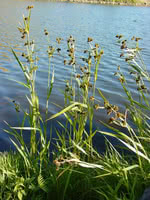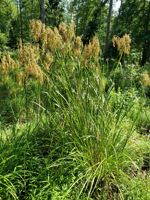Mon-Fri 9am - 5pm Mountain time
Green Bulrush vs Woolgrass
Scirpus pallidus
Scirpus cyperinus
CUSTOM GROW
CUSTOM GROW
Green Bulrush is a common waterside plant, suitable for erosion control and land reclamation. Despite this, Green Bulrush is very drought resistant once established. Bulrushes can cool nearby areas on hot days.
Unlike many of the other waterside plants available, Green Bulrush does not attract wildlife. This makes it a good choice for surrounding residential water sources.
Green Bulrush is topped with spiky balls of florets, green in the spring and fading to brown in the fall.
Woolgrass is a native perennial sedge that forms dense clumps in wetlands, ditches, and along shorelines. Its ability to thrive in saturated soils and shallow water, combined with its spreading growth habit, makes it especially valuable for waterside & riparian plantings, erosion control, ecological restoration, and naturalization projects.
The distinctive spikelets are covered in brown woolly bristles, which is where it gets the name Woolgrass. It produces seeds that are eaten by waterfowl and small mammals, while its dense stems offer cover and nesting habitat. It grows most actively in spring and fall, slowing or going dormant in the summer heat.

